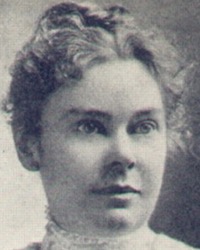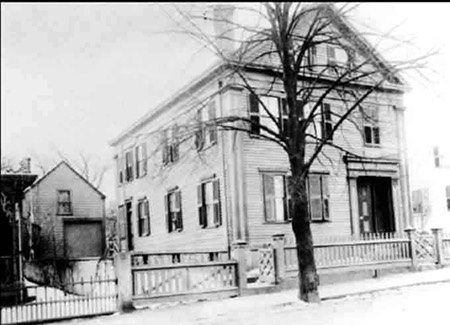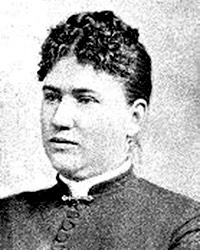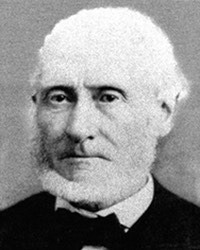Everyone knows the bit of cadenced verse that schoolgirls would chant while jumping rope or playing hopscotch. It lacks the whimsy of tales featuring the arachnophobic Miss Muffet and her footstool or Old King Cole making merry with his trio of violinists, but it takes the prize for macabre imagery.
Lizzie Borden took an axe
And gave her mother forty whacks
When she saw what she had done
She gave her father forty-one.
The rhyme describes an actual murder, though the particulars are inaccurate: the victim Abby Borden was not Lizzie’s mother but her stepmother, and the attacker struck her less than twenty times, not forty, and struck Andrew Borden ten times instead of forty-one. It’s also likely that the weapon was a hatchet rather than an axe. Finally, in positively identifying the murderer, the verse is arguably libelous. For unlike the mythical Muffet or the merry monarch lost in the mists of the ancient Welsh past, Elizabeth Andrew Borden was a real person. Strictly speaking, the little rhyme was actionable.
Her birthday is today, July 19, which in her natal year of 1860 fell just past midweek. That made her Thursday’s child, who is supposedly saddled with the fate of having “far to go.” There seems to have been something to that, but only in a figurative way. Miss Borden never traveled far from her home, if at all. Her mother died when Lizzie was only three, and Abby Gray married her father when Lizzie was but eight years of age. Her youth was uneventful, but that was a problem that persisted to make her marriageable years absent of suitors, possibly because she didn’t want any. As a result, she drifted into her thirties as a confirmed spinster living at home. The prospect of life for her was that of a lonely, far journey marked only by marking time.

Elizabeth Andrew Borden
Then in her thirty-second year came real trouble. On August 4, 1892, her father and stepmother were gruesomely murdered in the family dwelling on Second Street in Fall River, Massachusetts. A brief investigation convinced the authorities that Lizzie was the killer, a grand jury agreed, and she was put on trial in June 1893 for parricide.
The trial became a national sensation, but it also seemed an open and shut case. Investigators were certain they had all the components necessary for a successful prosecution. Lizzie had a motive, the means, and the opportunity to do the deed. Detectives also believed that additional circumstances clearly proved her guilt.
They believed they had quickly discovered Lizzie’s motive. In his early 70s, Andrew J. Borden was retired from a prosperous business career and living at 92 Second Street with his second wife of 25 years, 64-year-old Abby Durfee Gray. His daughters from his first marriage, Lizzie and her older sister, both unmarried, lived there too, as did a servant named Bridget Sullivan. Andrew was rich but parsimonious, and the house was described as physically uncomfortable. The lack of running water made hygiene a chore, and the father’s insistence on frugal meals meant consistently unappetizing fare with leftovers stretched for days. Sometimes spoiled food was blamed for making the family sick.

The house at 92 Second Street
But most telling, investigators discovered that the Bordens were an edgy bunch harboring barely veiled resentments and simmering jealousies. The relationship between Abby and her stepdaughters was never warm, and it had lately turned especially sour over their discovery that their father was giving valuable family properties to her. This had caused them to quarrel with their father and avoid their stepmother. Lizzie’s ill feeling toward her stepmother had been stoked by anger over being cheated out of her inheritance. Money was a classic motive for murder.

Abby Durfee Borden
As for the means, i.e. the method of the killing, it was obvious from the condition of the victims. Mrs. Borden was killed in an upstairs bedroom by 19 blows from a cutting tool striking her head and neck. Mr. Borden was killed while reclining on a sofa in the downstairs sitting room by ten blows, also from a cutting tool, with all wounds exclusive to his skull. The weapon was either an axe or a hatchet, and probably the latter, the police concluded, because Lizzie’s relatively diminutive size would have made it easier for her to wield. Mrs. Borden was assailed while she was standing and probably saw her killer deliver the first swinging blow, which glanced off her skull while knocking her to the floor. The killer either sat on her or kneeled at her side to finish the job. Mr. Borden was attacked by the killer standing at the end of the sofa to swing the implement straight down on his head. Police found 2 hatchets and 2 axes on the premises, and they surmised that one of the hatchets was the murder weapon because it was missing its handle, which would have been bloodied by the attacks.

Andrew Jackson Borden
As for opportunity, Lizzie had ample circumstances to commit the murders. On that August 4, her older sister was away visiting friends in a nearby town, and a visiting uncle was away from the house running errands in Fall River. Her father was also out of the house for the first part of the morning, and the servant Bridget was not only busy with chores but was coping with nausea. Lizzie was the only other person known to be in the house around 9:30 when Mrs. Borden was killed in the upstairs room. Mr. Borden returned home before 10:30 and went directly to the sitting room sofa for a nap before luncheon. He was killed during the ensuing half hour when Bridget Sullivan was trying to ward off another wave of nausea by taking a brief rest in her attic room, the farthest part of the house from the sitting room. Around 11:00, she heard Lizzie shouting, “Come down quick, father’s dead! Somebody’s come in and killed him!” Bridget ran to summon neighbors.
And finally, there was a ton of circumstantial evidence pointing to Lizzie Borden as the murderer. A pharmacist was willing to testify that she had tried to purchase prussic acid with the unconvincing explanation that she wanted to used it on a sealskin coat. The pharmacist had refused to sell it to her because of its dangerous toxicity. In addition, expert furriers were ready to attest that prussic acid was never used on sealskin. The conclusion was that Lizzie had wanted to use poison on her victims but was frustrated in that plan and had resorted to physical violence.
Her behavior on the day of the killings was more than suggestive of deceit and nefarious purpose. That morning Lizzie had tried to entice Bridget Sullivan into leaving the house to purchase dress cloth that was on sale, but Bridget was busy and too ill. In fact, she spent some time in the yard vomiting. When Bridget later noticed that Mrs. Borden was not around, Lizzie told her that Mrs. Borden had received a note that had called her from the house on some errand. No such note was ever found, and by time that Lizzie was referring to it, Mrs. Borden was probably already dead. Later while neighbors summoned by the horrified Bridget were finding the bodies, Lizzie changed her clothes, and several days later she burned a dress that she claimed had been ruined by wet paint. Her statements about this and other matters to police and her testimony at the inquest featured many additional inconsistencies regarding her whereabouts and movements on the morning of the crime.
The “open and shut” case against Lizzie Borden was argued by the prosecution and countered by the defense in a brisk trial that concluded on June 20, 1893. In less than 90 minutes the jury returned to the courtroom and announced its verdict. Elizabeth Andrew Borden was acquitted of all charges. It was later reported that the decision in the jury room had been made in only a few minutes, but its announcement was delayed to prevent accusations of hasty deliberation. By that afternoon, Lizzie Borden was free and clear and able to resume her life, such as it was.
Despite the acquittal, many people then and since have concluded that Lizzie Borden killed those two people that morning. The versifier employing the “forty whacks” line certainly thought so. On the other hand, the prosecution did not convincingly prove its supposedly airtight case. As is frequent in such matters, part of the failure resulted from dubious rulings by the court that barred damning evidence. For example, the three-judge panel presiding over the trial refused to allow the pharmacist’s or furrier’s testimony about the prussic acid on the rather slim rationale that Lizzie might have been genuinely misinformed about its use on coats. To suggest otherwise, ruled the judges, would be only speculative and harmfully prejudicial. The court also did not allow Lizzie’s contradictory statements at the inquest to be entered into evidence because she made them without benefit of counsel, which inquests did not allow. She was not under arrest at the time, but the court deemed that the manner of the proceedings amounted to an interrogation at her considerable disadvantage. The judges also allowed the defense to introduce testimony that the Borden family had a custom of disposing of soiled or ruined clothing by burning it.
But the most serious weaknesses in the prosecution’s case resulted from slipshod police work, which wasn’t all the police’s fault. Forensics was in its infancy, but even if sophisticated techniques had been common, the poor Fall River constables who first arrived at the Borden home had to be shocked by the scene there. Aside from the understandable limitations of a small town police force, even small town police forces were laboring under broad hardships. It will perhaps sound familiar that the police everywhere in the United States in the 1890s had fallen under suspicion for their allegedly aggressive tactics against rioting anarchists and violent pro-union demonstrations. They were suspected of mistreating prisoners and accused of manufacturing evidence to obtain convictions. The Bordens were an affluent family, and Lizzie was a respectable, church-going young woman.
The Fall River constabulary thus arrived at the house on Second Street on the afternoon of August 4, 1892, handcuffed by prevailing popular opinions about police investigative methods, and officers were accordingly careful to the point of negligence. They did not secure the premises but allowed neighbors to come and go at will, especially because they were comforting Lizzie. The police did not note times precisely and did not inventory the clothing in the house, which in the case of Lizzie’s closet should have included the dress she later burned. The officers who found the hatchet lacking a handle treated it carelessly and later disagreed about the disposition of the missing handle, one claiming it was nowhere to be found and the other saying it was nearby. There was no official memorandum to establish the truth regarding the ostensible murder weapon, which meant that as far as the court was concerned, it was never found. Most incredibly, the police did not search anyone in the house when they first arrived, and though by that time Lizzie had changed her clothes, she might have still been carrying some signs of blood that a thorough search would have revealed.
For it was the apparent absence of blood on Lizzie Borden that convinced the jury that more than a shadow of doubt clouded the certainty of her guilt. The five or six neighbors who came into the house within ten minutes of her calling out to Bridget did not see any blood on Lizzie Borden, but it isn’t clear how much time had passed after Andrew Borden’s murder before Lizzie alerted Bridget. Lackadaisical police searches aside, no bloody garment belonging to her was ever found, and no weapon with any discernible trace of blood was ever produced. The defense, on the other hand, examined experts to say that anybody who killed two people by vigorously swinging a hatchet or axe 29 times would have been spattered with a considerable amount of blood on clothes, skin, and hair.
For many people, though, it wasn’t a question of who killed the elder Bordens that August morning but how Lizzie had done it while avoiding detection, a theme that has spawned countless theories in fictional accounts and subsequent investigations, some quite reputable and many fabulously awful. The people of Fall River remained convinced of her guilt, and it was thus odd that Lizzie Borden chose to live out the rest of her life there. She and her sister moved out of the gloomy Second Street house and used the plentiful inheritance from their murdered father to purchase a larger dwelling in an upscale part of town, but nobody would have anything to do with her, and she knew the whispers continued about her to the day she died in 1927. She could be waited on by maids and driven around town by a fancy coachman all she wanted, but in passing schoolyards she possibly could hear a bit of macabre verse with her as its dark star.
Thursday’s child had far to go after all, being a person nobody would have ever heard of or remembered had she not gotten away with murder.